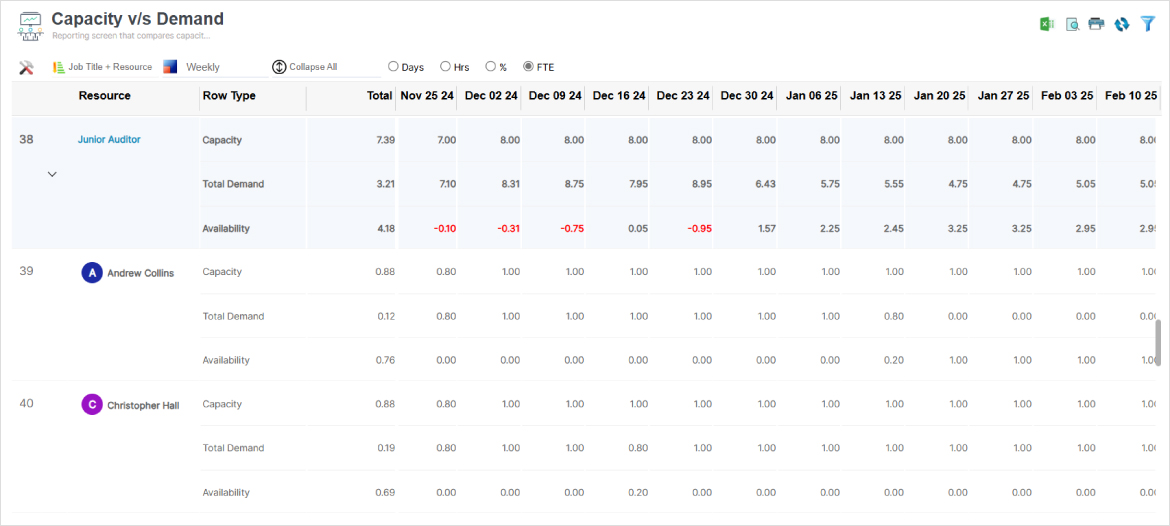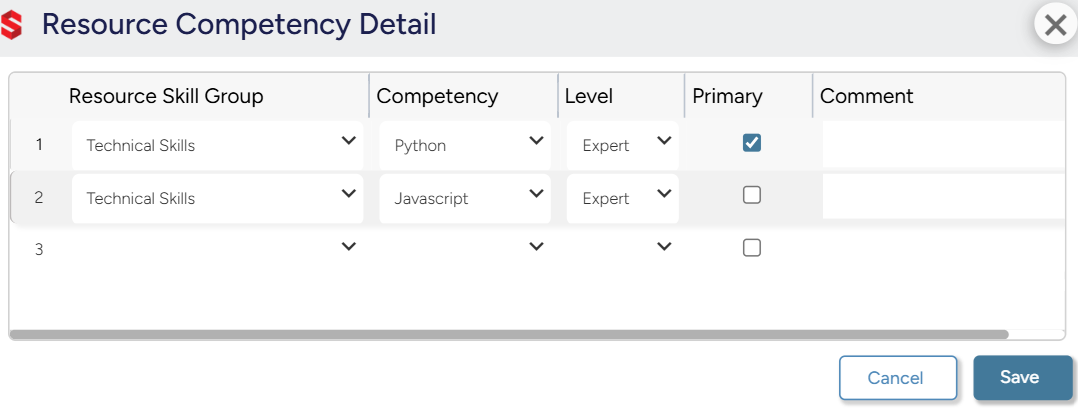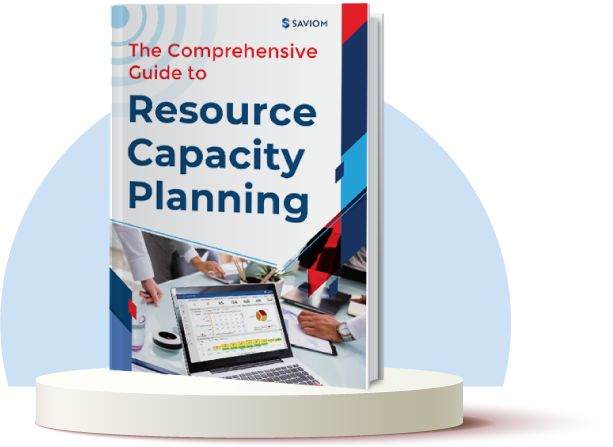Are you finding it challenging to predict project demand accurately?
Do you frequently face resource shortages at critical moments?
Are you struggling to streamline resource allocation due to a lack of foresight?
If you’ve answered “yes” to any of these questions, it’s time to implement an effective capacity forecasting framework.
In today’s rapidly changing business landscape, relying on approximation or guesswork is no longer an option for achieving sustainable growth. Without a clear understanding of future resource needs, businesses risk scrambling for skilled resources at the last minute, incurring high resourcing costs and jeopardizing project quality.
Effective capacity forecasting enables firms to anticipate future resource demands, build solid talent pipelines, and stay ahead of the competition.
In this blog, we will explore the nitty-gritty of capacity forecasting including definition, types, steps, challenges, and best practices.
Let’s dive in!
What is Capacity Forecasting?
Capacity forecasting is the process of anticipating the resources required to meet upcoming project demand or workload effectively.
By evaluating factors such as workforce availability, skills, competencies, experience, etc., businesses can determine whether their organization has the right talent pool to meet future project needs. This ensures informed decision-making, competent allocation of resources, and timely project initiation and delivery.
Now that we have clarified the definition let us dive into its types.
Types of Capacity Forecasting
Based on the business requirements, capacity forecasting can be classified into different types. Given below are a few –
Qualitative Forecasting
This approach to capacity forecasting relies on expert opinion, market research, and subjective judgments rather than numerical data. It is particularly used when historical data is limited or unavailable. Surveys, focus groups, and the Delphi method are some widely used approaches to gather insights and make informed decisions.
Quantitative Forecasting
Quantitative forecasting is a data-driven method that uses historical trends, statistical models, and mathematical techniques to predict future capacity needs. It relies on measurable data like resource utilization metrics or past workload patterns to ensure forecast accuracy. Prevailing methodologies include time series analysis and regression models.
Bottom-Up Forecasting
This forecasting method estimates future capacity needs by analyzing data at a granular level, starting from individual tasks, teams, or departments and then aggregating the results to form an overall forecast. Key techniques include sales pipeline analysis, workload-based or employee-based forecasting, etc.
Top-Down Forecasting
Top-down forecasting is a method that estimates future capacity needs by analyzing high-level business trends, overall market conditions, and organizational goals before breaking them down into specific resource requirements. Established methods include market growth analysis, economic indicators, benchmarking, etc.
Scenario Forecasting
Scenario forecasting is a technique used to predict and prepare for possible future outcomes by considering various “what-if” situations. Instead of just relying on one likely outcome, it explores multiple different scenarios based on changes in trends or external factors to better anticipate potential challenges or opportunities.
Demand Forecasting
Demand forecasting is predicting future customer demand for production, sales, supply, and project finances ahead of time. This insight enables firms to identify the types and quantities of resources required, ensuring their availability when needed to meet business objectives efficiently.
Resource-Based Forecasting
Resource-based forecasting is anticipating future resource requirements such as personnel, equipment, and finance for pipeline projects well in advance. This foresight provides firms with adequate lead time to prepare internal capacity, mitigating potential resource-centric bottlenecks and ensuring they can meet upcoming demands seamlessly.
Having understood its types, let us move on to the importance of capacity forecasting.
Why is Capacity Forecasting Important?
Capacity forecasting empowers businesses to meet project demands with confidence, ensuring the right quantity, quality, and type of resources are available to kick off and deliver projects on time. By identifying resource gaps early, businesses can take proactive measures to address talent or skill shortages, eliminating the need for last-minute expensive recruitment.
Additionally, capacity forecasting helps organizations identify the best-fit resources for each project based on various factors, including skills, experience, qualifications, and location. This ensures businesses optimize resource allocation, putting the right people in the right roles to deliver optimal results.
Finally, capacity forecasting provides insight into a resource’s billable and non-billable activities to determine resource utilization levels. Since non-billable work does not generate revenue, managers can reallocate resources to billable tasks, improving productivity and revenue generation, all while ensuring timely project completion.
Read More: What is Capacity Management & How to do it Effectively?
Given its importance, let’s now focus on a comprehensive step-by-step breakdown of how to perform capacity forecasting.
Steps to Perform Capacity Forecasting in Your Firm
Here are the essential steps firms should take to ensure they have the proper inventory to meet anticipated demand.
Foresee Pipeline Project Requirements
The first step in performing capacity forecasting is keeping track of potential pipeline projects to anticipate demand in advance. This allows you to gain a clear picture of the project scope, objectives, timeline, etc., enabling you to accurately determine the resources required to meet the requirement.
Assess Current Capacity Vs. Demand
Next, managers must evaluate whether the current capacity aligns with projected demand. By conducting a capacity vs. demand gap analysis, they can identify potential resource shortfalls or surpluses and take corrective actions for timely project initiation.

SAVIOM’s Capacity vs. Demand gap report allows managers to quickly identify resource shortages or excess, helping them to take corrective actions on time.
Bridge the Demand Gaps Seamlessly
To address capacity vs. demand gaps, managers can implement suitable resourcing measures such as cross-training/upskilling, out-rotation/backfill plans, or initiate targeted hiring in the case of resource shortages. For resource surpluses, firms can expedite project timelines or offer their expertise at discounted rates.
Read More: 10 Key Capacity Building Strategies to Boost Organizational Productivity
Model and Simulate Various Scenarios
Create and simulate various capacity plans by adjusting demand projections, resource allocations, project timelines, etc. This enables firms to evaluate how these elements affect overall capacity and, in turn, project outcomes. Consequently, they can identify and mitigate potential resource risks to better prepare for future challenges.
Implement a Capacity Model
Finally, leverage a well-designed capacity model to forecast resource requirements and identify potential capacity gaps. This enables managers to take proactive measures to address gaps, ensuring effective capacity management and helping your firm stay agile and prepared for future demands.
Read More: Capacity Model: Definition, Types, and 6 Best Practices to Build a Robust One
The following section will outline some common capacity forecasting challenges that firms often encounter.
Common Capacity Forecasting Challenges
While capacity forecasting provides valuable benefits, businesses frequently face several challenges in its implementation. The following section outlines some of the most common obstacles firms must navigate. Read on:
Fluctuating Market Conditions
Fluctuating market conditions create unpredictability in demand, driven by shifts in customer preferences, economic changes, and supply chain disruptions. This uncertainty makes it challenging to forecast future resource needs accurately. Consequently, businesses may face either excess capacity or shortages, leading to last-minute scrambling, high resourcing costs, delayed project delivery, etc.
Unexpected Scope Creep
Unexpected scope creep can alter original project requirements and timelines. As new tasks or features are added without sufficient lead time, predicting or securing the necessary resources becomes challenging. This can lead to overburdened teams or an under-equipped talent pool. As a result, businesses may struggle with meeting deadlines, managing workloads, and controlling costs.
Read More: What Is a Project Scope Document and How to Create an Effective One?
Lack of an Up-to-date Skills Matrix
When companies lack a clear and updated record of employee skills, expertise, certifications, experience, etc., they may struggle to compare internal resource capabilities against the projected demand accurately. This can result in misallocation of resources, project budget overruns, delays in task initiation and execution, and compromised quality.
Cross-Departmental Silos
When departments operate in isolation and fail to share critical information about resource availability, project timelines, or upcoming demands, it becomes difficult to assess the organization’s actual capacity. This lack of visibility and coordination can lead to double-booking, underutilization, or overallocation of resources, impacting project objectives and performance.
Over-Reliance on Legacy Tools
Legacy tools often lack the flexibility, scalability, and features required to handle modern business complexities. They may also fail to integrate with newer technologies or data sources, leading to incomplete or outdated information. As a result, firms may struggle to gain real-time insights into resource availability and demand, compromising forecasting accuracy and delaying decision-making.
Read More: 7 Reasons Why You Shouldn’t Use Excel for Resource Planning
Let us now move to some of the best practices of capacity forecasting.
Capacity Forecasting Best Practices
Firms can follow the below best practices to implement capacity forecasting:
Monitor Market Trends Regularly
Staying informed about industry trends, competitor strategies, economic shifts, and technological advancements helps businesses anticipate changes in workforce demand. By analyzing these factors, companies can identify emerging market opportunities, potential risks, and shifts in customer behavior that may impact workload requirements.
This proactive approach enables companies to anticipate changes and adjust their capacity plans accordingly. Moreover, it also ensures businesses are well-prepared to handle fluctuations in workload, avoiding sudden shortages or excess capacity. By incorporating market insights into forecasting practices, businesses can optimize resource planning, improve operational efficiency, and stay agile.
Gain Foresight into Project Requirements
Accurate capacity forecasting requires a deep understanding of upcoming project requirements. Businesses should work closely with project managers, clients, and stakeholders to assess workforce demand based on project scope, timelines, and complexity. This proactive planning ensures the right resources are available when needed, minimizing last-minute adjustments and disruptions.
Anticipating project needs also helps identify constraints such as skill gaps, capacity imbalances, dependencies, or risks that could impact execution. By addressing these challenges in advance, businesses can optimize resource allocation, prevent delays, and enhance overall project efficiency.
Read More: What is Resource Forecasting? A Guide for Project Managers
Build a Centralized Skills Inventory
A centralized skill inventory gives a comprehensive and real-time view of employee skills, expertise, and certifications across the firm. This enables managers to quickly identify the best-suited resources for upcoming projects while also highlighting skill gaps that may impact future demands.
By proactively addressing these gaps through targeted training or strategic hiring, businesses can avoid last-minute talent shortages. A well-maintained skills inventory also enhances agility, allowing companies to swiftly allocate resources in response to shifting project priorities or urgent requirements, ensuring seamless capacity planning.

SAVIOM’s embedded competency matrix helps managers track and update skills, competencies, expertise, etc., in real time.
Encourage Cross-Departmental Collaboration
When teams across different functions, such as sales, HR, or operations, work together, they provide diverse insights that enhance resource planning and overall organizational efficiency. This integrated approach enables businesses to assess future capacity requirements accurately.
It also helps identify resource gaps, overlapping demands, and hidden inefficiencies that may otherwise go unnoticed. As a result, organizations can make more informed decisions, optimize workforce utilization, and achieve better business outcomes through proactive and strategic capacity planning.
Read More: 10 Ways to Improve Cross-Departmental Collaboration
Leverage Historical Data
Using past data allows organizations to analyze historical performance and trends and make more accurate predictions about future resource needs. Managers can assess factors like utilization levels, demand fluctuations, project timelines, etc., to identify patterns. This minimizes guesstimations and enhances decision-making accuracy.
For example, law firms can leverage historical data to forecast their staffing needs during peak periods, such as tax season or financial year-end audits. By analyzing past case volumes, billable hours, and client demands, firms can predict when they will need additional legal resources or support staff and prepare accordingly.
Use Capacity Planning Software
Modern capacity planning software simplifies forecasting by providing real-time visibility into resource availability, workload distribution, and future project requirements, enabling businesses to proactively address capacity constraints.
Furthermore, capacity planning tools offer advanced analytics that give insights into resource-related risks, resource shortages or surpluses, etc. This helps organizations make informed decisions, allocate the right personnel, equipment, and facilities, and maintain seamless project execution.
Read More: What is Capacity Planning? An Ultimate Guide for Business Efficiency
Next, we shall see how powerful capacity planning software benefits an organization.
How Does a Modern Capacity Planning Tool Help Organizations Do Accurate Forecasts?
An advanced capacity planning tool can significantly enhance the ability of employees to accurately forecast, plan, and build a robust talent pool. Here’s how –
- The tool offers 360-degree visibility into the talent pool, allowing managers to gain insight into future pipeline projects and current and upcoming resource schedules.
- The embedded competency matrix keeps track of and records every employee’s current skill, competencies, certifications, etc., which helps identify and deploy the right resources for projects.
- The software’s forecasting and capacity planning feature enables managers to forecast pipeline project demand, identify resource shortages/excesses, and implement corrective measures to bridge them.
- The tool’s real-time BI reports, like utilization, project vacancy, people-on-the-bench, etc., offer detailed information about resource metrics like availability, capacity, utilization, and more, facilitating smooth capacity planning.
- Finally, the modeling and simulation module helps create and simulate various capacity forecasting scenarios by adjusting various key metrics to understand their impact and arrive at the most viable outcome.
Read More: How Can You Make Data-Driven Decisions with Resource Management Software?
Conclusion
Without accurate forecasting, businesses struggle with navigating resource requirements and identifying or addressing potential bottlenecks on time. However, by proactively measuring capacity and anticipating future needs, firms can streamline workflows, enhance organizational productivity, and drive long-term success seamlessly.
The Glossary
Read More: Glossary of Resource Workforce Planning, Scheduling and Management











